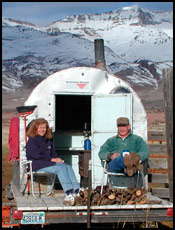
Ron Torell with his wife, Jackie.
Cow Camp Chatter
Self-disciplined ranch management needed.
Why does it take something like a drought or low cattle market to get the attention of those of us in the cow business? It was easy for us to become complacent with $1,200 yearlings, $900 calves and $1,000 market-ready cows. It seemed as if there would never be another bad day in the industry. With the cycle now moving in the opposite direction, we are thrust into a situation where forces outside of our control have brought on a downward trend and softer market. How do we deal with it?
Management factors
Mother Nature plays a huge role in influencing the market. Occasionally, it takes a crisis like a drought to force managers to follow good decisions. During up markets many become lackadaisical. Take, for example, zero-tolerance culling practices. During herd expansion, excuses are made for poor-producing cows. They remain in the herd. Management mistakes might be made, yet financially we keep our head above water.
During drought and tough times when every penny counts, the zero-tolerance rule is enforced in an effort to reduce inventory and generate operating income. Those cows who are dink raisers, late calving, aged, dry and/or may have poor dispositions or marginal udders are generally the first to leave the ranch. Remaining are the best lot of young to middle-aged cows ready to produce in the coming years. Prudent management techniques should be employed at all times regardless of whether the market is up or down.
Now more than ever the industry as a whole faces not only challenges from Mother Nature in the form of unprecedented droughts, but also political pressure in the form of environmental issues and government mandates. The global economy and demand for beef impact the market, as well.
Work hard and smart
It is imperative for producers to remain self-disciplined and stay focused on management. In order to survive, it is vital to manage resources in anticipation of what is to come. Supply and demand cycles are no longer as predictable as they once were. The successful manager knows exactly what his break-even cost of production figure is. Even in a down market, he is a price seeker rather than a price taker.
It is crucial for those who do not know their break-even cost of production to perform a complete enterprise budget analysis, which includes out-of-pocket expenses, as well as fixed and variable costs. With this knowledge, producers are then able to make use of some form of risk management. Risk management, a broad term used to describe a method of protecting or reducing the downside risk of production and marketing, is a feature many cattle people should consider employing.
Some in the cattle industry automatically associate risk management with futures and options contracts that are bought and sold on the Chicago Mercantile Exchange (CME). As effective as futures and options contracts may be when properly utilized, there is still a tremendous amount of distrust within the industry in respect to their use. Everyone knows of a neighbor or a friend who has had a wreck utilizing CME contracts. Recent news of greed and scandals associated with financial firms tied to the CME have added to this level of distrust.
Utilizing futures and options effectively requires not only the knowledge of your break-even cost of production but also a tremendous amount of education, training and self-discipline. One must put forth the effort required to climb the steep learning curve associated with trading contracts. Lack of knowledge pertaining to the internal workings of CME contracts and failure to exhibit the required self-discipline could very easily be the reasons for the wrecks many may have experienced. Keep in mind that risk management of this type isn't for the small producer. In order to fill contracts, it takes truckload lots of feeder cattle.
Another risk management strategy involves selling your product for a profit when the opportunity presents itself. For example, many had the opportunity to forward-contract spring-born calves and/or yearlings for fall delivery prior to the downward movement of the market. Few expressed the self-discipline to pull the trigger at that time. Many anticipated that the market was moving higher and were fearful they might miss out on selling at higher levels. Putting greed aside, those self-disciplined individuals who sold early for fall delivery used a form of risk management.
Becoming involved in the political effort to preserve the beef industry is another type of risk management. Again, this requires self-disciplined time management. Instead of sitting on the sidelines, become a part of the solution by joining local, state and national agricultural voice organizations such as the Farm Bureau and cattlemen's association. Assist in the educational effort to inform the general public about production agriculture by telling the real story.
The cattle industry has always been cyclic in nature. The benefit of tough times is improved management skills and/or enforcement of the skills we already possess. Knee-jerk crisis-management decisions based on emotion rather than logic generally spell long-term disaster and are a sign of a non-disciplined management style. It takes ambition and self-discipline to make ranching work. Working hard is not enough. We need to work hard and smart.
That's enough for this month. A special thanks to my wife, Jackie, for her part in writing "Cow Camp Chatter." As always, if you would like to discuss this article or simply want to talk cows, do not hesitate to contact me at 775-385-7665 or e-mail me.











